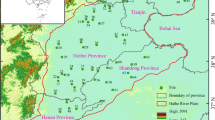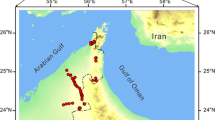Abstract
Variation of natural radioactivity level in the ground waters in the Arıklı uranium mineralization area, were investigated together with gross-α, gross-β, U, Th, K, EC and pH values. The U, Th and K values, which are mainly controlled by the geological features, varied over a wide range from 0.29 to 31.29 µg/L, 0.01–0.27 μg/L and from 0.44 to 37.29 mg/L, respectively. Although the U values of some water samples are higher than the WHO safe limits (15 ppb), all values of the gross-α and -β activity values and annual effective dose rates are lower than the drinking water safety limits of WHO (0.5 Bq/L, 1.0 Bq/L and 0.1 mSv/y, respectively).










Similar content being viewed by others
Change history
03 March 2022
A Correction to this paper has been published: https://doi.org/10.1007/s10967-022-08251-y
References
Clauser C (2011) Radiogenic Heat Production of Rocks, BT - Encyclopedia of Solid Earth Geophysics. In: Gupta HK (ed) Springer. Netherlands. https://doi.org/10.1007/978-90-481-8702-774
Plant JA, Saunders AD (1996) The radioactive earth Radiat Prot Dosim 68(1/2):25–36
Appelo CAJ, Postma D (2005) Geochemistry, groundwater and pollution. 2nd Edition, A. A. Balkema, Rotterdam
Osmond KJ, Cowart JB (1992) Ground water. In: Uranium Series Disequilibrium: Application to earth, marine and environmental science. Ivanovich M and Harmon R S (Eds), Oxford: Clarendon Press; New York, Oxford University Press. pp 290–333.
Chabaux F, Riotte J, Dequincey O (2003) U-Th-Ra fractionation during weathering and river transport. Rev Mineralogy Geochem 52(1):533–576. https://doi.org/10.2113/0520317
Porcelli D, Swarzenski PW (2003) The behavior of U- and Th-series nuclides in groundwater. Rev Mineral Geochem 52(1):317–361. https://doi.org/10.2113/0520317
Doi K, Hirono S, Sakamaki Y (1975) Uranium mineralization by ground water in sedimentary rocks, Japan. Econom Geol 70:628–646
Banks D, RØyset O, Strand T, Skarphagen H (1995) Radioelement (U, Th, Rn) concentrations in Norwegain bedrock groundwaters. Environ Geol 25:165–180
Reimann C, Hall GEM, Seiwers U (1996) Radon, fluoride and 62 elements as determined by ICP-MS in 145 Norwegian hard-rock groundwater samples. Sci Total Environ 192:1–19
Banks D, Frengstad B, Midtgård AK, Krog JR, Strand T (1998) The chemistry of Norwegian groundwaters: I. The distribution of radon, major and minor elements in 1604 crystalline bedrock groundwaters. Sci Total Environ 222:71–91
Frengstad B, Skrede AKM, Banks D, Krog JR, Siewers U (2000) The chemistry of Norwegian groundwaters: III. The distribution of trace elements in 476 crystalline bedrock groundwaters, as analysed by ICP–MS techniques. Sci Total Environ 31:21–40
Iwatsuki T, Yoshida H (1999) Groundwater chemistry and fracture mineralogy in the basement granitic rock in the Tono uranium mine area, Gifu Prefecture, Japan -Groundwater composition, Eh evolution analysis by fracture filling minerals. Geochem J 33:19–32
Örgün Y, Altınsoy N, Gültekin AH, Karahan G, Çelebi N (2005) Natural radioactivity levels in granitic plutons and groundwaters in southeast part of Eskisehir Turkey. Appl Rad Isotopes 63:267–275
Brindha K, Elango L, Nair RN (2011) Spatial and temporal variation of uranium in a shallow weathered rock aquifer in southern India. J Earth Syst Sci 120(5):911–920
Brindha K, Elango L (2013) Occurrence of uranium in groundwater of a shallow granitic aquifer and its suitability for domestic use in southern India. J Radioanal Nucl Chem 295:357–367. https://doi.org/10.1007/s10967-012-2090-6
Morales-Arredondo JI, Hernández MA, Hernández-Mendiola E, Estrada-Hernández RE, Bermea OM (2018) Hydrogeochemical behavior of uranium and thorium in rock and groundwater samples from southeastern of El Bajío Guanajuatese, Guanajuato Mexico. Environ Earth Sci 77(16):1–13
Bonotto DM, Bueno TO, Tessari BW, Silva A (2009) The natural radioactivity in water by gross alpha and beta measurements. Radiat Meas 44(1):92–101
Conthern CR, Rebers PA (1990) Radon, Radium and Uranium in Drinking Water. Lewis Publishers, USA, p 83
Bourdon B, Henderson G, Lundstrom C, Turner S (2003) Uranium–series geochemistry. Rev Mineral Geochem 52(1):1–21
UNSCEAR (2000) United Nations. Scientific Committee on the Effects of Atomic Radiation. Exposures from natural radiation sources, Report to the General Assembly, with SABNYU, Annexes B
Stalder E, Blanc A, Haldimann M, Dudler V (2012) Occurrence of uranium in Swiss drinking water. Chemosphere 86:672–679
Kayzar TM, Villa AC, Lobaugh ML, Gaffney AM, Williams RW (2014) Investigating uranium distribution in surface sediments and waters: a case study of contamination from the Juniper Uranium Mine, Stanislaus National Forest. CA J Environ Radioactiv 136:85–97
Riedel T, Kübeck C (2018) Uranium in groundwater-A synopsis based on a large hydrogeochemical data set. Water Res 129:29–38
WHO (World Health Organization) (2017) Guidelines for Drinking-water Quality, fourth ed., Chp. 9, p.203–218, Geneva
TS (2010) TS 9130 Doğal mineralli su Türk Standartları, Ankara (Natural mineral water Turkish Standards, Ankara) (2010) (in Turkish)
Top G, Örgün Y, Karahan G, Özcan O, Horvath M, Kampfl G (2020) At high background radiation areas the relationship between in situ indoor gamma dose rates and building materials: a case study from Arikli village (Ayvacik/Canakkale/Turkey). Radiat Prot Dosimetry 188(2):246–260
Top G, Örgün Tutay Y, Karahan G, Horvath M, Kampfl G (2020) Effects of local building materials on indoor gamma doses and related radiological health risks Ayvacik, Çanakkale/Turkey. Radiat Protect Dosimetry. https://doi.org/10.1093/rpd/ncaa086
Top G, Örgün Y, Ayazlı IE, Belivermiş M, Karacık Z, Kampfl G (2021) Determination of Ra-226, Th-232, K-40 and Cs-137 activities in soils and beach sands and related external gamma doses in arikli mineralization area (Ayvacik/Turkey). Radiat Prot Dosimetry. https://doi.org/10.1093/rpd/ncab035
Akgünlü H, Sağlam R (1983). Çanakkale-Ayvacık- Arıklı Köyü çevresindeki uranyum Cevherleşmesi. (MTA Rapor, No: 542) (in Turkish).
Günaydın A (2017) Geology and geochemistry of nodular-phosphate and fault-controlled hydrothermal-phosphate mineralizations in Arikli and Nusratli villages (Ayvacik-Çanakkale, NW Turkey). Bull Min Res Exp 155:131–146
Siyako M, Burkan KA, Okay AI (1989) Biga and Gallipoli tertiary geology and hydrocarbon possibilities (in Turkish), Biga ve Gelibolu yarımadalarının Tersiyer jeolojisi ve hidrokarbon olanakları. TPJD Bülteni 1(3):183–199
Karacık Z, Yılmaz Y (2001) Geology of ignimbirite eruptions of Ezine-Aycaık region NW Anatolia. Int. Earth Sci. Colloquium on the Aegean Region (IESCA) Proceedings. pp. 415–427
Sağdık Gönen N (1981) Çanakkale-Ayvacık Küçükkuyu uranyumlu fosfat cevherlerinin laboratuar çapta ön teknolojik deneyleri. MTA Rap.No:278, Ankara
Çiftçi NB, Temel RÖ, Terzioglu MN (2004) Neogene stratigraphy and hydrocarbon system of Edremit Bay (in Turkish), Edremit Körfezi civarının Neojen stratigrafisi ve hidrokarbon sistemi. TPJD 16(1):81–104
APHA (1996) Standard methods for the examination of water and wastewater, 20th edn. Water Works Association and Water Environment Federation, Washington
EPA (Environmental protection agency) (1980) Gross alpha and gross beta radioactivity in drinking water. Method 900.0., USA
Currie LA (1968) Limits for qualitative detection and quantification determination. Anal Chem 40(3):587–593
USA-EPA (1998) Federal Guideline Report No. 11. Limiting values of radionuclide intake and air concentration and dose conversion factors for inhalation, submersion and ingestion. EPA 520/1–88–020. Washington, DC, USA
ICRP (1991) 1990 Recommendations of the International Commission on Radiological Protection. ICRP Publication 60. Annals of the ICRP 21 (1–3)
Özen S, Goncuoğlu MC (2011) Origin of analcime in the Neogene Arikli tuff, Biga peninsula, NW Turkey. N Jb Miner Abh 189(1):21–34
Örgün Y, Karacık Z, Demiroğlu M, Erarslan C, Top G (2021) Arıklı Uranyum Mineralizasyon Sahasının Yeraltı Sularına Etkisi Ayvacık Çanakkale. Scientific Research Projects Unit of Istanbul Technical University project number: MGA-2018–41483, Project Final Report, unpublished.
Cuney M (2014) Felsic magmatism and uranium deposits. Bull Soc Geol Fr. https://doi.org/10.2113/gssgfbull.185.2.75
Saha S, Selim Reza AHM, Roy MK (2019) Hydrochemical evaluation of groundwater quality of the Tista floodplain, Rangpur. Bangladesh Appl Water Sci 9:198. https://doi.org/10.1007/s13201-019-1085-7
WHO (2004) World Health Organization’s Guidelines for drinking water quality. 1, 3rd edn, Recommendations, Geneva, p 515.
Read D, Andreoli MAG, Knoper M, Williams CT, Jarvis N (2002) The degradation of monazite: implications for the mobility of rare-earth and actinide elements during low-temperature alteration. Europ J Mineral. 14: 487–49845. EPA, 2011. National Primary Drinking Water Regulations – Code of Federal Regulations 40 CFR Part 141. 141.55, 141.66. United States Environmental Protection Agency.
EPA (2011) National Primary Drinking Water Regulations – Code of Federal Regulations 40 CFR Part 141. 141.55, 141.66. United States Environmental Protection Agency
WHO (2017) World Health Organization Guidelines for drinking-water quality: first addendum to the fourth edition. ISBN 978–92–4–155001–7
JISM (2008) Jordanian Drinking Water Standard. Jordan Institute of Standards and Metrology, Amman, Hashemite Kingdom of Jordan
Acknowledgements
This research was supported by the Scientific Research Projects Unit of Istanbul Technical University (project number: MGA-2018-41483).
Author information
Authors and Affiliations
Corresponding author
Additional information
Publisher's Note
Springer Nature remains neutral with regard to jurisdictional claims in published maps and institutional affiliations.
Thanks to Dr. Gyorgyi Kampfl from Institute of Mathematics and Basic Science, Chemistry Department of Hungarian University of Agriculture and Life Sciences (MATE), Gödöllö, Hungary for her valuable contributions. We would like to thank Editor and anonymous reviewers for their valuable comments, which greatly improved this manuscript.
Rights and permissions
About this article
Cite this article
Örgün Tutay, Y., Erarslan, C., Top, G. et al. Evaluation of gross-α, gross-β, U, Th and K values in groundwater and related health hazards: a case study, Arıklı mineralization area and its surroundings, Ayvacık, Çanakkale, Turkey. J Radioanal Nucl Chem 331, 65–78 (2022). https://doi.org/10.1007/s10967-021-08097-w
Received:
Accepted:
Published:
Issue Date:
DOI: https://doi.org/10.1007/s10967-021-08097-w




